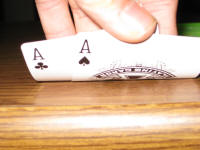Playing Big Pocket Pairs Preflop in No Limit Hold'em
 One of the biggest thrills in poker is looking down at your pocket cards, and squeezing out a pair of Queens, Kings, or Aces. Although these are the best preflop hands in the game, big pocket pairs can be tough to play, and many players lose huge pots because they do not understand how to play their hands preflop.
One of the biggest thrills in poker is looking down at your pocket cards, and squeezing out a pair of Queens, Kings, or Aces. Although these are the best preflop hands in the game, big pocket pairs can be tough to play, and many players lose huge pots because they do not understand how to play their hands preflop.
This article is going to discuss Queens, Kings, and Aces. I am not including Jacks because many players overplay Jacks and end up losing a lot of money in the long run - learn more about Playing Pocket Jacks or Playing Middle Pairs Preflop. Position, previous action, and your chip stack are all important factors that will help you determine the correct play with a big pair.
Position and Previous Action
The most important factor in deciding your preflop action with a big pair is your position at the table. The following strategy is for a 9-handed No Limit Hold'em table, and we will assume blinds of $1/$2:
Under the Gun
The first position to look at is being under the gun or in early position. It is very difficult to play big pairs under the gun as you have no idea what action will take place after your bet is made. You should open for a raise of about 4-5 times the big blind, so making a raise to $8-$10 total should be sufficient. This is a good raise because it is more than a standard bet, but also is luring enough for players to call or even re-raise with 1010 or JJ.
Middle Position
The next position will be when you are 3-5 seats from the button (also known as middle position). In these cases, you will have seen some action already which will allow you to fully understand how to play your hand. If your opponent makes a standard 3x the big blind raise and the action is on you with no other callers, then you should re raise about 2x-2.5x your opponent's raise. For instance, if the blinds are $1-$2 and your opponent makes it $8 then generally you should be raising to $24-$28.
Now if the someone else steps in and re-raises, or the initial raiser re-raises, you should lay down QQ. In some cases calling is the right play, but that will depend on your chip stack at the table and how your opponents have been playing (which will be discussed later). With KK or AA you should re-raise all-in.
Late Position
Now let's say you are on the cut off or on the button and there was a raise to $8 again, but this time there were two callers before you. There is already about $30 in the pot, so you need to make a substantial raise to at least $35. This bet should scare most players away, or should at least isolate an opponent.
Once again, if you do get re-raised then follow the above strategy, but most of the time that bet should take down the pot. If the action is on you and there are two-four limpers in the pot then once again you must make a healthy raise to about $10-$12 in order to isolate or simply take down the pot. As you can see, there has been no mention of slow playing your big pairs as that will backfire quite often.
Chip Stack
Another factor that will influence your play of big pairs preflop is your chip stack:
Short Stack
Anytime you have twenty-five big blinds or less, you are playing a short stack. Big pairs are pretty easy to play as the short stack, because you only have two options:
- If no one has raised, you make it $10 (at the $1/$2 table).
- If someone has raised, you go all-in.
Pretty simple. With a short stack you are never folding QQ, KK, or AA, because you need to take chances.
Average Stack
An average stack is any stack that is around one hundred big blinds. When you have an average stack, you have quite a few more options than all-in or fold; namely, you can fold Queens if the situation calls for it, and you can see flops with big pairs without getting too many chips in the pot.
With an average stack you are still never folding KK or AA, just because they are too strong of hands.
Big Stack
Anyone with more than two hundred big blinds at a table has a big stack. When you have that much money in play, you have to be slightly cautious in pots with other big stacks. If another player has you covered, you may want to seriously consider folding Queens or Kings if you are very confident the other player has Aces, or at least an A-K. Although you are mathematically ahead of A-K, you still may not be willing to risk your entire stack on a coin flip or an 80-20. Of course you should never fold AA preflop in a heads up pot, regardless of the situation.
Now that you know how to play premium pairs preflop, learn how to play big pairs on the flop and beyond.
